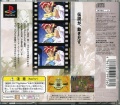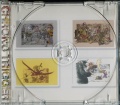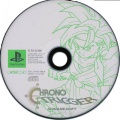Difference between revisions of "Chrono Trigger"
| Line 53: | Line 53: | ||
Poor emulation caused many common actions, like opening a menu screen or beginning a battle, to take several seconds due to load time, much to the unpleasant surprise of many gamers. Baffling fans, SquareEnix did not correct this problem with the Greatest Hits rerelease of Final Fantasy Chronicles. | Poor emulation caused many common actions, like opening a menu screen or beginning a battle, to take several seconds due to load time, much to the unpleasant surprise of many gamers. Baffling fans, SquareEnix did not correct this problem with the Greatest Hits rerelease of Final Fantasy Chronicles. | ||
| + | Waiting times in milliseconds: | ||
| + | |||
| + | These are measured in milliseconds, meaning every 1000 of these is 1 second: | ||
| + | <pre> | ||
| + | Chrono Trigger without Fast Read: | ||
| + | 9560 from title screen. | ||
| + | 11750 to load game from memory card. | ||
| + | 1750 to reach save menu. | ||
| + | 5550 to load menu. | ||
| + | 4400 to load map screen from menu. | ||
| + | 5170 to load battle from map screen. | ||
| + | 4340 to load map screen from battle. | ||
| + | 2080 to load a different map. | ||
| + | |||
| + | Chrono Trigger with Fast Read: | ||
| + | 6640 from title screen. | ||
| + | 8080 to load game from memory card. | ||
| + | 1600 to reach save menu. | ||
| + | 4280 to load menu. | ||
| + | 3570 to load map screen from menu. | ||
| + | 4340 to load battle from map screen. | ||
| + | 3740 to load map screen from battle. | ||
| + | 1870 to load a different map. | ||
| + | *Often froze with Fast Read enabled. | ||
| + | </pre> | ||
===More Information=== | ===More Information=== | ||
Revision as of 15:50, 14 January 2006
Contents
General Information
Chrono Trigger can also refer to:Chrono Trigger Sections
Background
Chrono Trigger (クロノ・トリガー) is a role-playing video game that was released in Japan on March 11, 1995 for the Super Famicom and in North America on August 22, 1995 for the Super Nintendo Entertainment System (SNES); it was re-released in 2001 for the Sony PlayStation (PS) as a part of the Final Fantasy Chronicles package, alongside Final Fantasy IV. The game has never been released in PAL territories.
Chrono Trigger is regarded as one of the best games of all time by many fans. It was made by a group referred to as "The Dream Team". The Dream Team was made up of Hironobu Sakaguchi (producer of the Final Fantasy series), Yuji Horii (scenario designer of the Dragon Quest games), character designer Akira Toriyama (of Dragon Ball Z and Dragon Quest fame), and music composers Yasunori Mitsuda (later known for Xenogears) and Nobuo Uematsu (of Final Fantasy fame.)
At the time of its release the ideas behind the game were revolutionary, involving multiple endings, a truly amazing variety of nearly endless items, a well developed story that gives each character a chance to shine, a smooth and innovative battle system, almost unparalleled graphics (relative to other games of the time), and much more.
Plot Details
Full plot summary: Chrono Trigger Condensed Plot Summary
Chrono Trigger is about a group of adventurers who travel across time to save the future. Along the way they recruit allies from other time periods in an attempt to defeat the alien parasite Lavos that is slowly destroying the planet. The player eventually gains seven playable characters (in the order that they join the group: main hero and silent protagonist Crono, rebellious princess Marle, studious inventor Lucca, android Robo, amphibian knight Frog, cave-woman Ayla, and the optional character, the dark wizard Magus). The group travels via time gates and the flying time machine Epoch to seven different time periods: the Prehistoric times (65000000 B.C.), the Dark Ages (ice age (12000 B.C.)), the Middle Ages (600 A.D.), the Present time (1000 A.D.), the Apocalypse (Day of Lavos, 1999 A.D.), the post-apocalyptic Future (2300 A.D.), and the very End of Time itself (represented as infinity).
One interesting note about Chrono Trigger is that the main character, Crono, never talks, though the other characters seem to act as though he does. This seems to be so the player can be in Crono's shoes, and talk for him. The one exception is in the "A Slide Show?" ending in which Crono says one line ("What ARE you two doing?! I thought you said something about a nice little slide show?"). Although this quirk was very common in RPGs years ago, such as Breath of Fire (except in the Final Fantasy series), Crono became almost universally identified with this peculiar 'muteness.'
Another interesting feature of Chrono Trigger is that the player can beat the final boss at almost any point in the game, using one of several means to initiate the final battle. When the final boss is beaten determines which ending of the game is shown, along with some other game-related events in some cases. Once the final boss has been beaten, the player may choose to start a new game or a "New Game+", where the stats of the characters and most of the items and money are retained in the new game. This makes is easier to play the game multiple times in order to view all of the endings.
Chrono Trigger uses an Active Time Battle (ATB) system. Each character in the player's party of 1-3 attacks after a certain time period has passed. Attacks can be with an equipped weapon (such as swords and bows) or using "techs". Techs are characters' special attacks which use Magic Points (MP). There are many combo-techs that require two or three characters. Chrono Trigger also has unique battles that take place at the actual spot of encounter (not in a generic battle area). There are no random battles while wandering on the overworld map, and players can avoid most battles in the game if they choose. The positions of the enemy and of the player's party are important for many techs. For example, some techs will damage multiple enemies only if they are close together. Other techs will attack in a straight line and only damage enemies in that path. Finally, some techs can only be performed if all party members are physically close together. Some of the most powerful techs in the game target all enemies on the screen.
Game Length
Some players consider one of the main problems with the game to be its short play time. It takes approximately 20 to 25 hours to complete the game, which is a very short timespan for a SFC/SNES RPG (Dragon Quest VI, for instance, takes about 100 hours), although it does take about 60-70 hours to max out everyone's stats. To mitigate the problem of length, the developers of the game created quite a few multiple endings that the player could earn, including several secret endings. The plot of each ending depends on which point in the storyline's progress the game is beaten. They also added a "New Game+" system, which allows the player to start a new game with all the various rare and powerful equipment, and the experience each character ended another game with. Money is not kept, however. This allows the player to reach all 12 endings very quickly.
Playstation Release
The remake for the PlayStation (released in the US as Final Fantasy Chronicles, packaged with a "remastered" version of Final Fantasy IV) features anime movies spread through the game at key sequences and an "extras mode." Each ending reached unlocks more of the following:
- All 10 of the added anime movies
- 69 songs from the game, including a few unused songs
- Statistics on all of the monsters
- A list of all of the endings with a screenshot from each
- An art gallery with 16 anime-style drawings of characters
- A list of all characters' techs
- Descriptions of the bosses
- A "treasure map" which shows the locations of hidden items
Poor emulation caused many common actions, like opening a menu screen or beginning a battle, to take several seconds due to load time, much to the unpleasant surprise of many gamers. Baffling fans, SquareEnix did not correct this problem with the Greatest Hits rerelease of Final Fantasy Chronicles.
Waiting times in milliseconds:
These are measured in milliseconds, meaning every 1000 of these is 1 second:
Chrono Trigger without Fast Read: 9560 from title screen. 11750 to load game from memory card. 1750 to reach save menu. 5550 to load menu. 4400 to load map screen from menu. 5170 to load battle from map screen. 4340 to load map screen from battle. 2080 to load a different map. Chrono Trigger with Fast Read: 6640 from title screen. 8080 to load game from memory card. 1600 to reach save menu. 4280 to load menu. 3570 to load map screen from menu. 4340 to load battle from map screen. 3740 to load map screen from battle. 1870 to load a different map. *Often froze with Fast Read enabled.
More Information
Contrary to popular belief, the character Schala and a rumored ninth character were never playable. Top ROM hackers have investigated the game's code; entire data structures would have had to be changed for two extra characters to exist, and the code that supposedly proves this assertion, 1981-E46F, only fools the game into thinking one party member exists, allowing the options screen to scroll down two more slots. Despite this, a scrolling character menu would never have been programmed if the game was designed from the start to have seven playable characters (as seven can fit on a single screen without scrolling). Additionally, rumored sprite data and extra animations of Schala have never been found. Only two strange sprites beneath the main party's overworld sprites hint of an unused character, and no conclusions can be drawn.
A pre-release beta version was leaked to the Internet in July 1999. Large parts of the game were not programmed, and entering those unfinished areas causes the game to freeze. The music is slightly different in certain areas, and Ayla is missing as a playable character (though her sprites are in the ROM). Many NPCs are missing. The famed "Singing Mountain" area is actually accessible, complete with its music, though the area was never finished. Information on the other story, character, map, and battle changes are available in StarNeptune's Chrono Trigger beta FAQ. However, StarNeptune's FAQ was created by GameFAQs users, who included several false assertions (such as the "extra playable characters" rumor, that 65000000 B.C.'s continent is much larger than its final counterpart, that much of Magus's history is in the Prerelease and was cut in the final, and others). The differences within Prerelease have been fully documented and mapped as images by the Chrono Compendium at Chrono Trigger Prerelease. Additionally, the ROM hacker JLukas has developed codes that enable exploration of the areas that previously caused the games to crash; they are stored at the Compendium.
Chrono Trigger features an event tracking system, which is used to update the save screen's "chapter title", change certain characters' dialogue, and alter the maps to conform to the current position in the story. It is also used for bug and consistency checking. If events happen out of order (such things can happen if the cartridge save RAM is corrupt, or if the player uses a Game Genie code to walk through walls and skip over certain events), the Nu (as Balthasar) will appear in front of the doorway to Epoch's construction bay in 2300 AD, and proclaim "The Time Axis is out of alignment." Aside from this warning, the game will continue normally, which can allow for such things as already having Magus in your party when you fight Magus in 600 A.D.
Lastly, Geiger, a longtime ROM hacker and modifier, has released an editor for Chrono Trigger called "Temporal Flux" that allows the free drawing and editing of any Location or Overworld in the ROM, the changing of any text string in the game, and the altering of event code. Though this allows most aspects of Chrono Trigger to be changed and restructured, editing event code is still very difficult, and support has not yet been added for sprite editing and other features. However, updates are planned, as Geiger aims to enable the editing of everything within the game.
Sequel
A side story for Chrono Trigger was released for Nintendo's Satellaview add-on for the Super Famicom and was called Radical Dreamers. The original Radical Dreamers was a very short, text-based game, available only in Japan. Radical Dreamers was remade to form the beginning sequence of Chrono Trigger's better known PlayStation sequel, Chrono Cross.
Additionally, there are a number of fan-based Chrono Trigger sequels and remakes in the works. See Fan Projects.
Media
Images
- Fcbox2.jpg
Japanese Box Art
From: Games</gallery>













